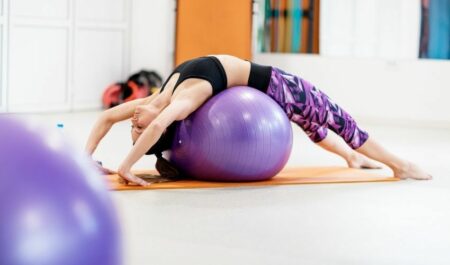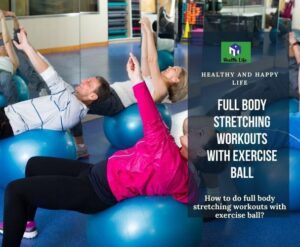Stretching is an essential part of every successful and well-balanced fitness routine. It helps to avoid injury while also increasing range of motion as well as flexibility. Stretches with exercise ball can also help balance your workout, simply by releasing the tight muscle groups, all of which were compressed throughout your resistance and weight training sessions.
There are a variety of stretching techniques and also props that may be used to help muscles stretch. However, we’re going to concentrate on a full-body stretch with the help of a physioball. Below we have acknowledged the best exercise medicine ball workouts.

Hip Stretches With The Exercise Ball
Hip Rotator Stretch
- Stretch on a mat with your knees bent and the back of your calves and heels on an exercise ball.
- Rest your arms on the floor. Take a few deep breaths to help your hips sink into the mat.
- Then bend one leg and place the ankle on the opposite knee while contracting your core muscles.
- Pull up your thigh and knee off the exercise ball-bound leg to your chest. Also, maintain the heel on the ball along with the other leg in place ankle on the opposite knee.
- Repeat this stretch multiple times. Make sure you slide the ball beneath your heel to hold it. Switch sides halfway through.
Reverse Extensions
This exercise is beneficial to your glutes, quadriceps, and hamstrings. You can also do this exercise as an abs exercise with medicine ball.
- Lie down on the stomach over the exercise ball and support yourself with your hands and toes for reverse extensions.
- Ring your legs up and parallel to the floor.
- Then walk your hands forward to keep your hips are firmly on the ball.
- Finally, squeeze your legs together and align them with the body in a straight line.
- Slowly drop both legs simultaneously to the floor while maintaining control.
- Don’t let your knees bend or your core muscles relax. Exhale on the forward step and inhale as you lower your legs.
- Repeat the walk forward and leg rise to parallel multiple times.
Neck Stretches With An Exercise Ball
The goal of using an exercise ball is to assist stabilize the cervical spine. Additionally, it builds the muscles that support your neck.
Neutral Stretches
Hold the ball in the centre of your forehead and gently pull it forward. Then stand approximately a foot away from the wall you’re facing. The neutral stretches with exercise balls are what it’s called.
Forehead Stretches
Turn your body so that your shoulder is parallel to the wall, and stand tall. The neutral position is when the ball is placed just above your ear and softly pressed. You might use your hand to keep the ball stable.
Side Stretches
Turn your back to the wall and stand 6-12 inches from the wall with your feet shoulder-width apart. Place the ball just against the little bump you have on the back of the head. Draw a “W” with your head at this point, focusing in the centre of the “W” first. Then, gently press your back against the ball. This is side stretches with an exercise ball.
Lower Back Stretches With An Exercise Ball
Lay Back
It is the simplest of all the exercises. This motion helps to lengthen your spine from top to bottom and counteract the natural bend in your upper back.
- Lie down on the ball with your back against it and your feet flat on the ground.
- Reach your hands upward and attempt to touch the floor to make this more effective.
- Pause for a few seconds while keeping your body calm. This is a lay back stretches with exercise ball.
Circular Rotation
This motion is great for your hips since it stretches both the back and hip paraspinal muscles. It’s critical to keep your balance while doing this workout.
- Place your feet firmly on the ground and your hands on your hips.
- Then sit on top of the exercise ball.
- Rotate in one direction for as long as you can. Keep your spine straight before turning in the other way. Pause for a few seconds.
Whole-Body Stretches With An Exercise Ball
Pike & Twist
- Begin in a plank position with your right foot on the stability ball.
- Your left foot should rest inside your right calf and your left knee pointing toward the mat.
- Lift your hips into the air to form an upside-down “V” with your body.
- Then rotate your torso to the right to bring your left knee across your body and toward your right hip.
- Return to the starting position by bringing the left knee back under the left hip. That counts as one rep. This is one of the best medicine ball abs exercises.
Bear Plank Tuck
Start in a plank posture with toes pointing and shins and feet on the stability ball. Next, pull knees forward under hips while engaging the core and maintaining hips level. To return to the plank position, repeat the process. That counts as one rep.
Half Moon
Kneel on the mat with your seat on your heels and a stability ball between your hands. Raise your arms over your head, biceps by your ears. Bend at the waist to lower the stability ball to the left side of the mat without moving your lower body. Return to the center and repeat the process on the other side. That counts as one rep.
Exercise Ball Stretches For The Upper Back
Rock Back & Forth
Place your arms to the sides or on your hips while sitting on the exercise ball. To flatten the back, slowly conduct a pelvic tilt, pushing stomach muscles in and sliding hips slightly toward the front (reduce lordosis).
On the exercise ball, return to a neutral posture. Next, slightly arch the small of your back and slide your hips toward the rear. On the exercise ball, return to a neutral posture. Make these motions constantly back and forth for ten repetitions after being comfortable with them on the exercise ball.
Rock Side–to–Side
Place your arms to the sides or on your hips while sitting on the exercise ball. Shift your weight to the right slowly. Return to a state of neutrality. Next, shift your weight to the left slowly. On the exercise ball, return to a neutral posture. When you’re comfortable with these motions, repeat them ten times side to side.
Exercise Ball Exercises For Beginners
Knee Folds On The Exercise Ball
This exercise can help you engage your abdominals and back muscles to stabilize your spine and pelvis posture on the ball, which is great for developing balance.
For example, if you maintain your legs parallel, you’ll activate your inner thighs; if you’re on a deep crease at the hip as you elevate your knee, you’ll start to distinguish leg movement from hip movement, which is crucial efficient movement.
Chest Lift
A fantastic abdominal workout is the chest raise. It targets both the upper and lower abs. To keep steady, you’ll need to engage your legs and glute (butt) muscles. Take a seat on the ball. Roll down on the ball with your back supported by the ball by walking your feet out and pulling your abs in and up. You’ll probably be a touch off-kilter with the ground.
Exercise Ball Stretches For The Back
Lay Back Over The Ball
This stretch will feel especially pleasant if you spend your day in a cubicle. “It gives you a stretch in the front of your body. The abdominals and iliopsoas muscles are the major culprits. We lean forward during the day at our desks, which causes these muscles to tighten,” We is explaining.

This also permits the spine to mobilize and reverse the natural ‘kyphotic’ curvature in the upper back, which can become unduly rounded due to bad posture. It’s a simple stretch, but it has a big impact.”
Trunk Side Stretch
Sit with a neutral lumbar posture on the exercise ball. The chest should be up, the shoulder blades should be down and back, and the head should be back over the shoulders.
Maintain a shoulder-width or slightly wider distance between your feet on the ground. Bend your left knee and stretch your left hand to the ceiling as you roll the ball to the left. Maintain your current position.
Stretches With The Small Ball
Neck
If you’re quite susceptible to tension headaches, or you may notice your neck tightening just after a full day in front of the computer, try massaging your neck only with a tennis ball for some minutes, maybe. This is one of the exercise ball core exercises.
Just lie down and lay a tennis ball behind the neck, close to the right of your spine and simply behind your head. Sink your head into the tennis ball and roll it left and right, sparing your bony portions. Stop and hold your position for 30 seconds if you come across a close location. After a minute or two, switch sides.
Glutes
The Medius, gluteus maximus, and minimus make up the glutes, which are among the strongest muscles in the body. These muscles are also in charge of practically all of your thigh motions. It means you use them a lot. Even if you’re not in pain, I’m sure you’ll feel some tightness after trying this one.
Begin by bending your knees and placing your feet on the floor. Put a tennis ball behind the right glute and raise yourself a bit by supporting yourself with your hands behind you.
Slowly roll until you reach a tight location, then stay still. Next, cross your same-side leg over your opposite thigh and bend your same-side elbow to increase the utilization of gravity.
Final Thoughts
For novices, the essential thing is to get started with some easy, safe, and efficient exercises with the exercise ball. After that, depending on one’s desire, skill, and back condition, there are a vast range and diversity of back exercises that may be done on an exercise ball.
So that’s it we have acknowledged all the exercise ball workouts for back pain. Stretches with exercise ball can have an impact on your body in different ways.
Which exercises have you tried to stretch your body? Share your experiences below.
